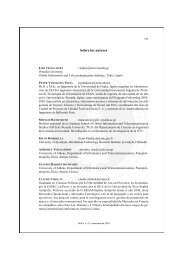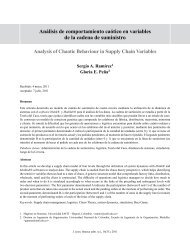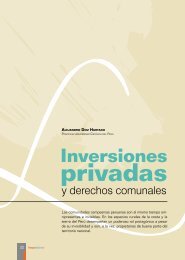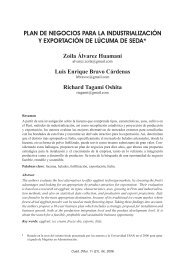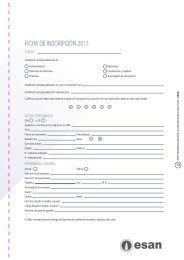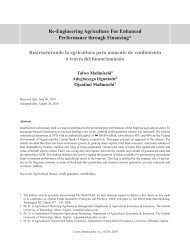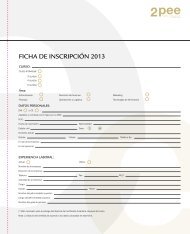Hofstede's Cultural Dimensions and Tourist Behaviors: A ... - Esan
Hofstede's Cultural Dimensions and Tourist Behaviors: A ... - Esan
Hofstede's Cultural Dimensions and Tourist Behaviors: A ... - Esan
You also want an ePaper? Increase the reach of your titles
YUMPU automatically turns print PDFs into web optimized ePapers that Google loves.
46 Journal of Economics, Finance <strong>and</strong> Administrative ScienceDecember 2011intentions. Such insights enable the marketers to designeffective strategies related to products <strong>and</strong> promotionsgeared toward different segments.As discussed earlier, culture is the broadest determinantof human behavior <strong>and</strong> exerts a direct as well asan indirect (through social, personal, <strong>and</strong> psychologicalfactors) influence on consumer behavior. Tourism istruly a complex global phenomenon <strong>and</strong> the influenceof culture on behavior is especially salient in the field oftourism compared to other services. Hofstede’s culturaldimensions are very widely acknowledged <strong>and</strong> referredin this context, <strong>and</strong> the current study exp<strong>and</strong>s our underst<strong>and</strong>ingof the applicability of these dimensions tovarious types of tourist behaviors <strong>and</strong> the underlyingprocesses through which such influences work.FUTURE RESEARCHThere is a wealth of research done in the field of travel<strong>and</strong> tourism that acknowledges the importance of culture<strong>and</strong> compares the behavior of tourists from differentnationalities. However, the research studies that specificallyuse Hofstede’s cultural dimensions as explanatoryvariables for their findings are rather limited. Therefore,there is ample scope for cross-cultural tourism researchusing theoretical frameworks such as those developed byHofstede <strong>and</strong> his colleagues. Considering the complexityof culture <strong>and</strong> the complexity of the field of travel <strong>and</strong>tourism, it is not surprising therefore that the investigationof mechanisms <strong>and</strong> theoretical processes underlyingthe influence of culture on tourist behaviors has beenrelatively limited. We feel that there is an immense scopefor developing in-depth theories of cross-cultural touristbehavior. Hofstede’s cultural dimensions have proven aneffective tool for underst<strong>and</strong>ing cultural differences in avariety of fields dealing with human behavior; certainly,the field of travel <strong>and</strong> tourism will benefit a great dealfrom further research related to the extension <strong>and</strong> applicationsof these cultural dimensions. The conceptualframework developed in our research provides withsome further insights into the relative dominance of thevarious cultural dimensions in different stages of travelbehaviors. The processes suggested here are, however,contemplative <strong>and</strong> there is room for further development<strong>and</strong> testing of these <strong>and</strong> other processes underlyingthe influence of various cultural dimensions on touristbehaviors. This suggests need for both conceptual <strong>and</strong>empirical research on this subject.ReferencesBeatty, S. E., Lynn, R. K., & Pamela, H. (1991). PersonalValues <strong>and</strong> Gift Giving <strong>Behaviors</strong>: A study AcrossCultures. Journal of Business Research, 22, 149-157.Bello, D., & Etzel, M. (1985). The Role of Novelty inPleasure Travel Experience. Journal of TravelResearch, 40, 172-183.Bond & the Chinese <strong>Cultural</strong> Connection (1987). ChineseValues <strong>and</strong> the Search for Culture-free <strong>Dimensions</strong>of Culture. Journal of Cross-<strong>Cultural</strong> Psychology,18(2), 143-164.Bond, M. H., & Lee, W.H. (1978). Face Saving in ChineseCulture: A Discussion <strong>and</strong> Experimental Study ofHong Kong Students. In M. H. Bond (Ed.) SocialLife <strong>and</strong> Development in Hong Kong. Hong KongChinese University Press.Carr, N. (2001). An Exploratory Study of Gender Differencesin Young <strong>Tourist</strong>s’ Perceptions of Danger withinLondon. Tourism Management, 22, 565-570.Chon, K. S. (1992). Self-image/Destination-image Congruity.Annals of Tourism Research, 19(2), 360-363.Crotts, J. (2004). The Effect of <strong>Cultural</strong> Distance onOverseas Travel <strong>Behaviors</strong>. Journal of TravelResearch, 43(August), 83-88.Crotts, J. & Erdmann, R. (2000). Does National CultureInfluence Consumers’ Evaluation of Travel Services?A Test of Hofstede’s Model of Cross-cultural Differences.Managing Service Quality, 10(5), 410-419.J. econ. finance adm. sci., 16(31), 2011



